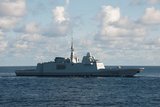Harris unveils Falcon Wideband Team Radio
Harris Corporation has unveiled its first true non-developmental solution to address requirements of the US Army's Rifleman Radio and NettWarrior programmes: the Falcon Wideband Team Radio. Called the Falcon RF-330E, the radio delivers voice, data and situational awareness to the squad member.
According to the company, the RF-330E is the smallest and lightest soldier radio addressing the requirements of the Rifleman Radio and NettWarrior programmes.
The RF-330E is a wireless radio for connecting front-line soldiers to the tactical Internet to facilitate command and control. The radio delivers real-time position location information and multiple talk groups, while also supporting additional combat applications.
George Helm, president, Department of Defense business, Harris RF Communications, said: ‘The new Harris radio demonstrates that competition works. Given the opportunity by the [Department of Defense], Harris developed a breakthrough team radio with significant performance improvements over the current JTRS programme of record radio. We also are investing in solutions for next-generation manpacks and vehicular wideband radios using this same commercially oriented business model, which is proven to deliver continuous innovation across our entire tactical radio portfolio.’
The RF-330E is a non-Cryptographically Controlled Item that meets Type-1 Secret and Below information security requirements. The radio hosts the Soldier Radio Waveform, which delivers simultaneous voice, high-speed data and real-time position location information. The radio utilises the same widely fielded battery and charging systems as the Harris Falcon III AN/PRC-152A, easing the logistical burden, reducing sustainment costs, and lightening the soldier’s load.
Harris said the RF-330E was introduced and demonstrated at the recent US Army Expeditionary Warfighting Experiment at Fort Benning, Georgia. Soldiers deployed the radio during the exercise in a configuration supporting the US Army NettWarrior End User Device.
Helm added: ‘One of the strengths of our business model is our ability to listen to the user. Armed with invaluable feedback, we have developed a power-efficient radio that offers extended battery life for reduced total mission weight, and state-of-the-art network monitoring capabilities that provide the user with crucial information on radio and network status.’
More from Digital Battlespace
-
![Babcock nears first customer for Nomad AI translation tool]()
Babcock nears first customer for Nomad AI translation tool
Nomad can provide militaries with real-time intelligence, saving critical time on the battlefield.
-
![AUSA 2025: Israel’s Asio Technologies to supply hundreds of improved Taurus tactical systems]()
AUSA 2025: Israel’s Asio Technologies to supply hundreds of improved Taurus tactical systems
Taurus operates alongside the Israel Defense Forces’ Orion system which supports mission management across tens of thousands of manoeuvring forces, from squad leaders to battalion commanders.
-
![AUSA 2025: Kopin pushes micro-LED plans as China moves faster]()
AUSA 2025: Kopin pushes micro-LED plans as China moves faster
The plan for the new displays follows fresh investment in Kopin’s European facilities by Theon and an order for head-up displays in fielded aircraft, with funding from the US Department of Defense.
-
![AUSA 2025: Persistent Systems to complete its largest order by year’s end]()
AUSA 2025: Persistent Systems to complete its largest order by year’s end
Persistent Systems received its largest ever single order for its MPU5 devices and other systems earlier this month and has already delivered the 50 units to the US Army’s 4th Infantry Division.
-
![Aselsan brings in dozens of companies and systems under the Steel Dome umbrella]()
Aselsan brings in dozens of companies and systems under the Steel Dome umbrella
Turkey has joined the family of countries attempting to establish a multilayered air defence system with government approval in August 2024 for the effort landed by Aselsan. Dubbed Steel Dome, the programme joins Israel’s Iron Dome, the US Golden Dome, India’s Mission Sudarshan Chakra and South Korea’s low-altitude missile defence system.
-
![DSEI 2025: MARSS unveils new agnostic multidomain C4 system]()
DSEI 2025: MARSS unveils new agnostic multidomain C4 system
MARSS’ NiDAR system has been deployed using sensors from static platforms to provide detection and protection for static sights, such as critical infrastructure, ports and military bases.




























